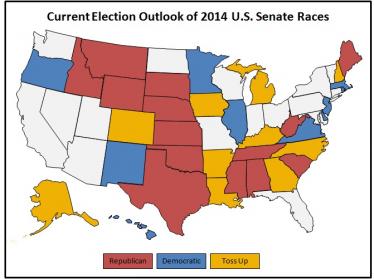

[[{"type":"media","view_mode":"media_large","fid":"4489","attributes":{"class":"media-image aligncenter size-full wp-image-19672","typeof":"foaf:Image","style":"","width":"671","height":"501","alt":""}}]] The three Democratic retirements in Montana, South Dakota, and West Virginia are critical to Republican majority chances. Sweeping this trio of states will put them in launching position to assume Senate control, so it is imperative, from the GOP perspective, that the candidates run mistake-free campaigns in each place.
Counting the three conversions and those races currently in the Republican column, the GOP would then have 46 seats as compared to the Democrats' 44, with 10 undecided. Eight of the 10 are now in Democratic control, meaning the Republicans have achieved their early cycle goal of expanding the political playing field. It is also possible that three more states could conceivably become competitive before November arrives, each in Democratic control. Those are Minnesota (Al Franken), Oregon (Jeff Merkley) and Virginia (Mark Warner). The GOP could hit a major bump in the road, however, if they stumble in several primaries, resulting in weak general election candidates. The situation in Georgia and Mississippi, and potentially Kansas, could yield primary upsets, which may well change the general election picture. Assuming no surprises in the 26 campaigns (16R wins; 10D victories) in states highlighted above in blue or red, the majority will be decided in the 10 most hotly contested general election races. They are:- Alaska (Mark Begich)
- Arkansas (Mark Pryor)
- Colorado (Mark Udall)
- Georgia (open; Saxby Chambliss retiring)
- Kentucky (Mitch McConnell)
- Iowa (open; Tom Harkin retiring)
- Louisiana (Mary Landrieu)
- Michigan (open; Carl Levin retiring)
- New Hampshire (Jeanne Shaheen)
- North Carolina (Kay Hagen)
Of these 10, Republicans gain the majority by winning any five races, exactly half of the subset. Doing so would propel them to 51 seats. Democrats retain control by winning any six of the 10.
Once more, the importance of Montana, South Dakota, and West Virginia emerges for Republicans. Converting the seats actually permits them to win a smaller number of the battleground states than their counterparts, even though the former begins in a distinct minority. Failing to sweep the aforementioned three returns the edge to the Democrats, and greatly diminishes GOP chances of seizing majority control. Should the playing field expand to include Minnesota, Oregon, and Virginia, then Republican chances grow even stronger, as all three are Democratic-held states. If the battleground number does increase, then the GOP would only need to win five of the 13 to gain control, whereas Democrats would be forced to win nine to retain power.For more information, please contact David Ashinoff at (202) 547-5013 or ashinoffd@agc.org.